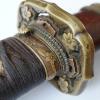-
Posts
724 -
Joined
-
Last visited
-
Days Won
2

EdWolf replied to Bruce Pennington's topic in Military Swords of Japan

EdWolf replied to Tom Darling's topic in General Nihonto Related Discussion


